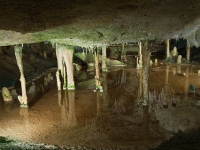
The tourist attraction cave complex of Cova de Can Marca sits a few miles north of Sant Miquel, a village with an attractive hilltop church and good tapas bars. The caves have been commercialised and fitted with some spectacular sound and lighting effects, providing for an entertaining guided tour. The caves are situated atop a rocky inlet, with spectacular views over the bay and of the islands Murada and Feriradura. The cave is said to be more than 100,000 years old and features underground lakes, stalactites, and stalagmites. There was once a natural waterfall in the cave system but the waterfall featured on the tour today is a replica, as the waterbeds of the cave system are now fossilized. The caves were once used by smugglers to hide their cargo and it is still possible to see the marks they made on the walls to guide them through the cave system. Tours are held in various languages and take about 40 minutes. The tours are suitable for people of all ages and fitness levels and are very popular with tourists. It is not necessary to book in advance.
Telephone : +34 971 334 776
Opening times : 10.30am to 1.30pm and 2.30pm to 8pm (May to October); 11am to 5.30pm (November to April).
Admission : €10 (adults), €6 (children aged 4 - 12).
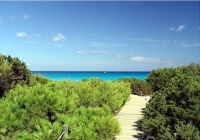
The tiny island of Formentera covers 35 square miles (90 sq km) and is home to just over 5,000 people. It can be reached by ferry from Ibiza Town, with a regular service running every two hours. Ferry services to Formentera from the mainland have also been established, due to the island's increasing popularity. It's relatively unspoilt by tourism development, although not as empty of crowds as it once was. Accommodation options are very limited. The main attractions are some pretty villages and marvellous beaches flanked by palms and pines, many frequented by nudists. The best way to explore is on a rented moped or bicycle, as there are well-maintained cycling tracks traversing the island. The main port is La Sabina, and other villages include beautiful Las Salinas, San Francisco Javier, and San Fernando, all featuring quaint white-washed houses. Recommended beaches are Es Pujols in the north, Mitjorn in the south, and Cala Saona in the west. Other beaches of note are En Boster, Ca'n Xico Mateu, and the natural port of Es Calo. The highest point on the island is in the southeast corner at El Mirador.

The old medieval district of Ciudad de Ibiza (Ibiza Town), the capital of the island, sports narrow cobblestone streets, picturesque whitewashed houses and Gothic buildings around courtyards bright with blooming geraniums and bougainvillea. Ibiza'a Old Town is a UNESCO World Heritage Site, with architecture spanning 2,500 years of history. The Old Town, enclosed by historic walls, is best entered through the Puerta de las Tablas, which sees visitors passing across a drawbridge flanked by ancient statues; there is another entrance, Portal Nou, behind the Plaza del Parque, which is somewhat less dramatic. The district is best explored on foot, and contains some interesting sights, most noteworthy of which is the Archaeological Museum. The museum, situated in Cathedral Square, contains artefacts from prehistoric sites on the Balearic Islands, dating as far back as the Punic period between the 5th and 7th centuries BC. Interestingly, the museum is said to be constructed on a Carthagean burial site of about 4,000 graves. Also in the Old Town is the cathedral with its 10th-century Gothic tower and 18th-century Baroque nave. From the battlements by the cathedral spectacular views can be enjoyed. There are plenty of gift shops, art galleries, pavement cafes and good restaurants in the area to keep tourists happy. The Old Town is delightful at night, and a candlelit dinner at one of the restaurants spilling out into the narrow cobbled streets is a must.
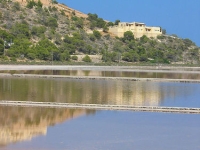
The salt flats of Las Salinas are some of Ibiza's most famous landmarks, close to the airport on the southernmost tip of the island. They've been used for more than 2,000 years since the Carthaginians traded with the salt left in the pans after the waters evaporated in summer. The sparkling lakes provide one of the world's most beautiful sunset photograph opportunities. The fashionable Las Salinas beach on the southern tip of Ibiza attracts a glittering crowd of sun worshippers and party animals, including many celebrities, the wealthy, and the beautiful. There are numerous beach bars to try out. The salt flats can be found in the nature reserve that surrounds this gorgeous beach, along with pine forests, sand dunes, and a general abundance of natural beauty. The saltpans are also a wonderful destination for bird watchers. It is possible to just stroll into the woods from the beach, but there are also many tours to and from various towns on Ibiza.
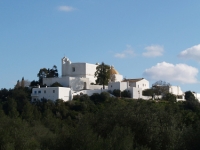
Santa Eulalia is a pretty, atmospheric little town about nine miles (14km) north of the island's capital, much favoured by tourists because of its proximity to some of the best beaches and for its scenic setting. The town is situated on the estuary of the only river in the Balearic Islands, overlooked by the Puig de Missa, a 16th-century fortified church situated on a hilltop. There are also a number of small museums and the remains of a Roman necropolis. Another attraction in Santa Eulalia is the Sant Carles settlement a few kilometres to the north: the last true hippie commune on Ibiza remaining from the 1960s, when hippie cultists flocked here. The famous northern beaches of Ibiza, like Aigues Blanques and Cala Llonga, can be reached by bus or boat from the town. Santa Eulalia has its own beaches though: the Santa Eulalia beach has Blue Flag status and is very popular; the Es Calo de S'Alga beach, which can be reached on foot from the town, is a gorgeous little beach with calm, shallow water and good facilities; and the nearby Es Canar beach is perfect for water sports like jet-skiing.
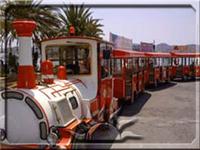
This mini train departs from Platja d'Es Canar along a variety of routes around the island. The gentle pace and open sides are ideal for watching the scenery roll by. The train stops off at scenic places for the kids to stretch their legs and sunbathe or swim. The Sant Carlos and Beaches route takes three hours and stops at some of the more remote beaches on the island. The highlight of this tour is the village of Sant Carlos with its picturesque 18th-century church. The Santa Eulalia evening tour takes about two hours and gives passengers the opportunity to see the quaint village of Santa Eulalia, where visitors can stroll along the promenade or engage in some souvenir shopping. The three-hour Environment and Culture tour allows visitors to explore the spectacular Ibiza landscapes before stopping for snacks at a 17th-century farmhouse. Photo enthusiasts should take the train along its Prtinatx - Puerto San Miguel - Cala San Vicente route. Passengers on this route get the opportunity to explore many of Ibiza's beaches, wonderful shopping opportunities, and the scenic white churches of Sant Llorenc, Sant Vicente, and San Joan, as well as the oldest church-fortress on the island, the 13th-century Sant Miquel.
E-mail : [email protected]
Telephone : +34 971 339 772

Travel Guide powered by Word Travels, copyright © 2023 Globe Media Ltd. By its very nature information in this travel guide is subject to change at short notice and travellers are urged to verify information on which they're relying with the relevant authorities. Neither Globe Media Ltd nor Travel Vogue can accept any responsibility for any loss or inconvenience to any person as a result of information contained above.